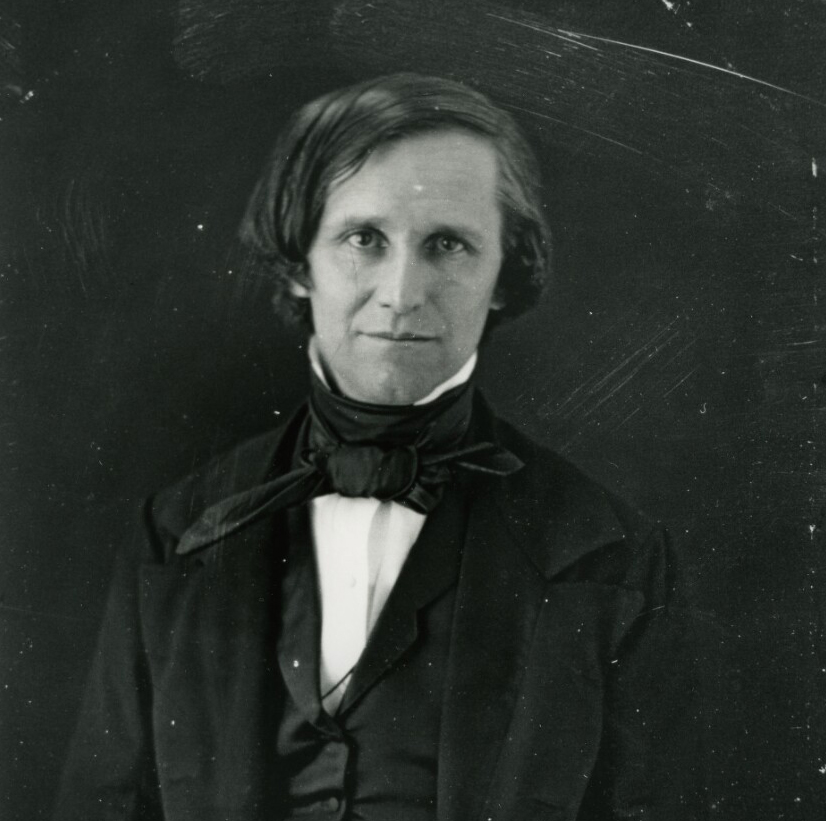A new era of instruction was initiated with the hire of John Barbee Minor in 1845. Minor remained at the helm of the Law School for 50 years. In his History of the University of Virginia, Philip Alexander Bruce describes Minor’s personality as a young lawyer: “From the hour of his first admission to the bar, he had displayed all those qualities which afterwards so conspicuously distinguished him as an instructor. It is said that, even as a young lawyer, he exhibited extraordinary powers of analysis; that he refused to ask for or accept any relaxation in the stiffest requirements of pleading; and that he showed familiarity with the most obscure and abstruse rules and forms of practice, but, at the same time, was equally well informed about the broad general principles of jurisprudence.” A rigorous and demanding instructor, in Minor’s first ten years of teaching, a mere nine percent of his students passed the exam and earned a Bachelor of Laws degree. His experience as a legal practitioner influenced the way he structured his law courses, affording students the opportunity to combine practical skills with a systematic study of the concepts of law. In 1870, Minor was persuaded to publish his Institutes of Common and Statute Law, cementing his reputation as the leading legal professor in the South and boosting the enrollment of the Law School dramatically.[1]
Minor studied closely the history of slave codes in both Virginia and other states. From his diary, it can be surmised that although he doubted the constitutionality of secession, he eventually came to believe it was necessary to protect the South and its institutions. Although he denounced older Virginia laws regulating fugitive slaves as inhuman, he supported the Federal Fugitive Slave Act of 1850 and stated that Vermont’s attempted nullification of that law was unconstitutional.[2] Student notes from the period indicate that Minor believed slavery was necessary because “we could not possibly get along, or exist as a society if slaves were emancipated.”[3] Minor himself owned enslaved persons while he was a professor at the law school. The 1850 Federal Slave Schedule lists six people enslaved by John B. Minor, and the 1860 Slave Schedule lists ten.[4] Based on ages, it seems likely that few or none of these were the same people across the decade. Minor’s May 11, 1863 tax list includes the names and ages of 21 enslaved people.[5] Minor’s personal papers also indicate that Minor rented enslaved workers to and from other slaveholders during his tenure as law professor.
Despite the rigor of his course and examinations, Minor earned the loyalty and admiration of scores of law students during his 50-year tenure at the helm of the Law School. He allowed financially strapped students to defer payment of fees until they were established in practice and put considerable time into writing recommendations that would enable students to secure good positions upon graduation. In 1870 he established a summer law course for practitioners who needed to supplement their practical skills and knowledge of the law. Minor retired from teaching just weeks before his death in July 1895.[6]
[1] “John Barbee Minor,” University of Virginia Arthur J. Morris Law Library, accessed 26 August 2020.
[2] John B. Minor Diary, 90-92, 249-252, Albert and Shirley Small Special Collections Library, University of Virginia.
[3] James L. Hubard Notebook, 1856-1857 and 1860-1861, quotation from October 26, 1860 lecture, University of Virginia Student Notebooks Collection, 1827-1882, Albert and Shirley Small Special Collections Library, University of Virginia.
[4] 1850 and 1860 United States Federal Census—Slave Schedules, ancestry.com.
[5] John B. Minor Tax List, May 11, 1863, transcript. See also this list of Minor’s relatives and enslaved persons.
Sources
Books
- A Synopsis of the Law of Crimes and Punishments in Virginia (W.S. Young, 1858; M.W. Hazlewood, 2d ed. 1869)
- Institutes of Common and Statute Law (Whittet & Shepperson/J.B. Minor, 1875-80; 2d ed. 1876-95; 3d ed. 1882-93; 4th ed. 1891-92)
- Exposition of the Law of Crimes and Punishments (J.B. Minor, 1894)
Articles
- Historical Sketches of Virginia: Literary Institutions of the State: University of Virginia, 4 Old Dominion, 148-157, 195-205, 260-268, 325-332, 415-419, 507-518, 608-619, 651-660, 719-729 (1870); 5 Old Dominion 55-62, 120-122, 203-208, 265-268, 324-330 (1871)
Other
- Facts and Hints Relative to Free Schools, Addressed Particularly to the People of Albemarle (J. Alexander, 1849) [In Special Collections AB v.82 no. 2 and F221 v.299 no.6]
- The Farewell Address of John B. Minor to His Graduating Classes (University of Virginia, 1954)
- John B. Minor’s Civil War Diary, 22 Mag. Albemarle County Hist. 45-55 (1963)

